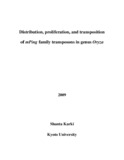Please use this identifier to cite or link to this item:
http://archive.nnl.gov.np:8080/handle/123456789/234| Title: | Distribution, proliferation, and transposition of mPing family transposons in genus Oryza |
| Authors: | Karki, Shanta |
| Keywords: | Oryza sativa L. Oryza Wild rice - Oryza rufipogon Griff. mPing |
| Issue Date: | 9-Nov-2017 |
| Abstract: | The belief that TEs are solely selfish and parasitic DNA sequences is beginning to change and the prospect of TEs as important genetic entity have been given scientific recognition. The importance of TEs is accounted for creation of genetic variations and for adaptive evolution of genomes. Among different types of TEs, MITEs are likely to contribute significantly in gene regulation and host genome evolution, because MITEs are usually present as high copy number elements in genomes and prefer to insert within or near genes. In rice (Oryza sativa L.), MITE is the numerically predominant type of TE. This indicates that MITEs have significantly contributed to rice genome evolution. However, the research resolving how MITEs and rice genome coevolved could not be carried out, because no MITE family had been shown to be actively transposing until mPing was identified. In order to elucidate the impact of MITE on rice genome evolution, it is necessary to analyze distribution, proliferation, and transposition of mPing family transposons in genus Oryza. In this study, presence and distribution of eight kinds of MITEs identified in O. sativa (Castaway_Os1, Ditto-Os1, Kiddo, mPing, Mashu, Stowaway2_Os like, Stowaway17_Os like, and Wanderer) were investigated in 19 Oryza species. PCR amplifications revealed that Mashu, Wanderer, and Stowaway17_Os like MITE are present in all species of AA genome. Castaway_Os1 is present in all the AA genome species excluding O. meridionalis. Stowaway2_Os like MITE is present in O. punctata (BB, BBCC) and O. minuta (BBCC) besides every AA genome species. Kiddo is present in AA, BB, BBCC, and CC genome species. Ditto_Os1 has the widest distribution among the eight MITEs analyzed because of its presence in species with AA, BB, BBCC, CC, CCDD, EE, and FF genomes, whereas mPing has the narrowest distribution. mPing is present only in two species, O. rufipogon and O. sativa, among the 19 species assessed. These results indicate that Ditto_Os1 is the oldest among all the MITEs examined in this study and mPing had originated later than the other MITEs during the evolutionary process of genus Oryza: in other words, mPing is a comparatively young MITE. Usually, young TE remains actively mobile in the genome. Thus, mPing may be still active not only in O. sativa but also in O. rufipogon. In order to verify the possible mobilization of mPing in O. rufipogon, distribution of autonomous elements, Ping and Pong, was investigated in 37 O. rufipogon accessions. As a result, Pong was detected in all accessions, whereas Ping was present in 17 out of 37 accessions. Transposon display (TD) analysis revealed that the insertion sites and copy numbers of mPing varied considerably among the O. rufipogon accessions. A phylogenetic tree constructed by using haplotypes around qSH1 which is a major QTL responsible for the reduction of seed shattering showed that O. rufipogon accessions used in this study could be divided into three major clusters independent of the copy number of mPing and the presence of Ping. These results propose that the mPing family had already evolved and was present in the common ancestor of the O. rufipogon accessions, and that, later on, Ping was eliminated from the genomes of some of the accessions by random drift and/or natural selection along with the advancement of diversification in O. rufipogon. Moreover, O. rufipogon accessions were found to have several Kiddo elements at the same chromosomal positions. Thus, insertion polymorphisms and different copy number of mPing in O. rufipogon accessions indicate that mPing may be currently active even in O. rufipogon. Possible mobilization of mPing in O. rufipogon accessions suggests the availability of mPing in transposon tagging system for Oryza species other than O. sativa. The distribution of mPing family transposons was investigated in NERICA lines that are the interspecific lines developed by crossing a tropical japonica variety as the recurrent parent to an O. glaberrima variety as the donor parent followed by eight generations of inbreeding to fix the lines. NERICA lines and the recurrent parent had mPing and Pong but no Ping, whereas the donor parent had no mPing family transposons. In TD analysis, NERICA lines produced de novo bands that are not in the recurrent parent, indicating that mPing transpose from the original position to another position in these lines. Locus specific PCR confirmed that de novo bands in TD gel were the consequence of mPing de novo insertions, and mPing preferentially transposed to single copy regions or near transcribed DNA in NERICA lines. Moreover, de novo bands of Pong were detected in 11 NERICA lines. From these results, it was found that the mobilization of mPing and Pong in NERICA lines was most probably activated by introgression of exogenic genome from the donor parent, O. glaberrima. Furthermore, the results of the present study provide sufficient evidences for the development of mPing into an efficient gene tagging tool for functional genomics and molecular characterizations of various rice species, varieties, and cultivars. |
| Description: | A thesis submitted to Kyoto University, 2009. |
| URI: | http://103.69.125.248:8080/xmlui/handle/123456789/234 |
| Appears in Collections: | 500 Natural sciences and mathematics |
Files in This Item:
| File | Description | Size | Format | |
|---|---|---|---|---|
| ShantaKarkiPhDThesis.pdf | 1.83 MB | Adobe PDF |  View/Open |
Items in DSpace are protected by copyright, with all rights reserved, unless otherwise indicated.